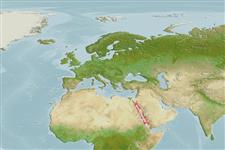Common names from other countries
>
Eupercaria/misc (Various families in series Eupercaria) >
Caesionidae (Fusiliers) > Caesioninae
Etymology: Caesio: Latin, caesius, bluish-grey, 1835; it is the same name given to the silvery metal (Cs) (Ref. 45335).
More on author: Klunzinger.
Environment: milieu / climate zone / depth range / distribution range
Ökologie
seewasser riff-verbunden; standorttreu; tiefenbereich 2 - 25 m (Ref. 9710). Tropical; 31°N - 11°N, 32°E - 45°E (Ref. 402)
Indian Ocean: Red Sea to the Arabian Sea.
Size / Gewicht / Alter
Maturity: Lm ? range ? - ? cm
Max length : 35.0 cm TL Männchen/unbestimmt; (Ref. 402)
Rückenflossenstacheln (insgesamt) : 10; Rückenflossenweichstrahlen (insgesamt) : 14 - 15; Afterflossenstacheln: 3; Afterflossenweichstrahlen: 12. With 4-5 scales on cheek; 21-24 predorsal scales; scaled dorsal and anal fins; narrow scaleless zone at dorsal midline interrupting Supra-temporal band of scales. Upper peduncular scale rows usually 11 (10-11); lower peduncular scale rows usually 14 or 15 (13-15). Most of body light to silvery blue, paler ventrally. Black blotch at the tip of each caudal-fin lobe bordered proximally by a white band. Presence of a small process on each ventrolateral surface of basioccipital for attachment of Baudelot's ligament. Post maxillary process single; posterior end of maxilla blunt.
Inhabits coastal areas, primarily on coral reefs. Forms large midwater aggregations and feeds on zooplankton. Oviparous, with numerous, small pelagic eggs (Ref. 402).
Life cycle and mating behavior
Maturities | Fortpflanzung | Spawnings | Egg(s) | Fecundities | Larven
Carpenter, K.E., 1987. Revision of the Indo-Pacific fish family Caesionidae (Lutjanoidea), with descriptions of five new species. Indo-Pac. Fish. (15):56 p. (Ref. 1723)
IUCN Rote Liste Status (Ref. 130435)
CITES (Ref. 128078)
Not Evaluated
Bedrohung für Menschen
Harmless
Nutzung durch Menschen
Fischereien: kleinfischerei
Tools
Zusatzinformationen
Download XML
Internet Quellen
Estimates based on models
Preferred temperature (Ref.
115969): 24.5 - 29.3, mean 28.4 (based on 114 cells).
Phylogenetic diversity index (Ref.
82804): PD
50 = 0.5020 [Uniqueness, from 0.5 = low to 2.0 = high].
Bayesian length-weight: a=0.01259 (0.00551 - 0.02875), b=3.09 (2.90 - 3.28), in cm Total Length, based on LWR estimates for this (Sub)family-body shape (Ref.
93245).
Trophic level (Ref.
69278): 3.4 ±0.45 se; based on food items.
Widerstandsfähigkeit (Ref.
120179): hoch, Verdopplung der Population dauert weniger als 15 Monate. (Preliminary K or Fecundity.).
Fishing Vulnerability (Ref.
59153): Low vulnerability (25 of 100).
